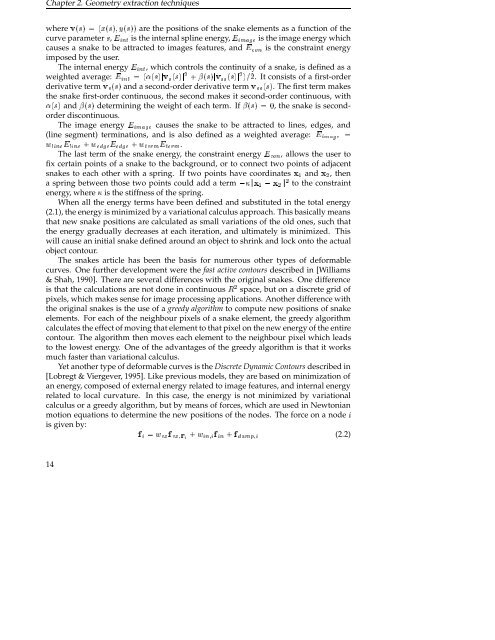Chapter 4 Vortex detection - Computer Graphics and Visualization
Chapter 4 Vortex detection - Computer Graphics and Visualization
Chapter 4 Vortex detection - Computer Graphics and Visualization
You also want an ePaper? Increase the reach of your titles
YUMPU automatically turns print PDFs into web optimized ePapers that Google loves.
<strong>Chapter</strong> 2. Geometry extraction techniques<br />
where Ú × Ü × Ý × are the positions of the snake elements as a function of the<br />
curve parameter ×, ÒØ is the internal spline energy, Ñ is the image energy which<br />
causes a snake to be attracted to images features, <strong>and</strong> ÓÒ is the constraint energy<br />
imposed by the user.<br />
The internal energy ÒØ, which controls the continuity of a snake, is defined as a<br />
weighted average: ÒØ « × Ú× × ¬ × Ú×× × . It consists of a first-order<br />
derivative term Ú× × <strong>and</strong> a second-order derivative term Ú×× × . The first term makes<br />
the snake first-order continuous, the second makes it second-order continuous, with<br />
« × <strong>and</strong> ¬ × determining the weight of each term. If ¬ × , the snake is secondorder<br />
discontinuous.<br />
The image energy Ñ causes the snake to be attracted to lines, edges, <strong>and</strong><br />
(line segment) terminations, <strong>and</strong> is also defined as a weighted average: Ñ <br />
ÛÐÒÐÒ Û ÛØÖÑØÖÑ.<br />
The last term of the snake energy, the constraint energy ÓÒ, allows the user to<br />
fix certain points of a snake to the background, or to connect two points of adjacent<br />
snakes to each other with a spring. If two points have coordinates Ü <strong>and</strong> Ü , then<br />
a spring between those two points could add a term Ü Ü to the constraint<br />
energy, where is the stiffness of the spring.<br />
When all the energy terms have been defined <strong>and</strong> substituted in the total energy<br />
(2.1), the energy is minimized by a variational calculus approach. This basically means<br />
that new snake positions are calculated as small variations of the old ones, such that<br />
the energy gradually decreases at each iteration, <strong>and</strong> ultimately is minimized. This<br />
will cause an initial snake defined around an object to shrink <strong>and</strong> lock onto the actual<br />
object contour.<br />
The snakes article has been the basis for numerous other types of deformable<br />
curves. One further development were the fast active contours described in [Williams<br />
& Shah, 1990]. There are several differences with the original snakes. One difference<br />
is that the calculations are not done in continuous Ê space, but on a discrete grid of<br />
pixels, which makes sense for image processing applications. Another difference with<br />
the original snakes is the use of a greedy algorithm to compute new positions of snake<br />
elements. For each of the neighbour pixels of a snake element, the greedy algorithm<br />
calculates the effect of moving that element to that pixel on the new energy of the entire<br />
contour. The algorithm then moves each element to the neighbour pixel which leads<br />
to the lowest energy. One of the advantages of the greedy algorithm is that it works<br />
much faster than variational calculus.<br />
Yet another type of deformable curves is the Discrete Dynamic Contours described in<br />
[Lobregt & Viergever, 1995]. Like previous models, they are based on minimization of<br />
an energy, composed of external energy related to image features, <strong>and</strong> internal energy<br />
related to local curvature. In this case, the energy is not minimized by variational<br />
calculus or a greedy algorithm, but by means of forces, which are used in Newtonian<br />
motion equations to determine the new positions of the nodes. The force on a node <br />
is given by:<br />
ÛÜ ÜÖ ÛÒ Ò ÑÔ (2.2)<br />
14

















